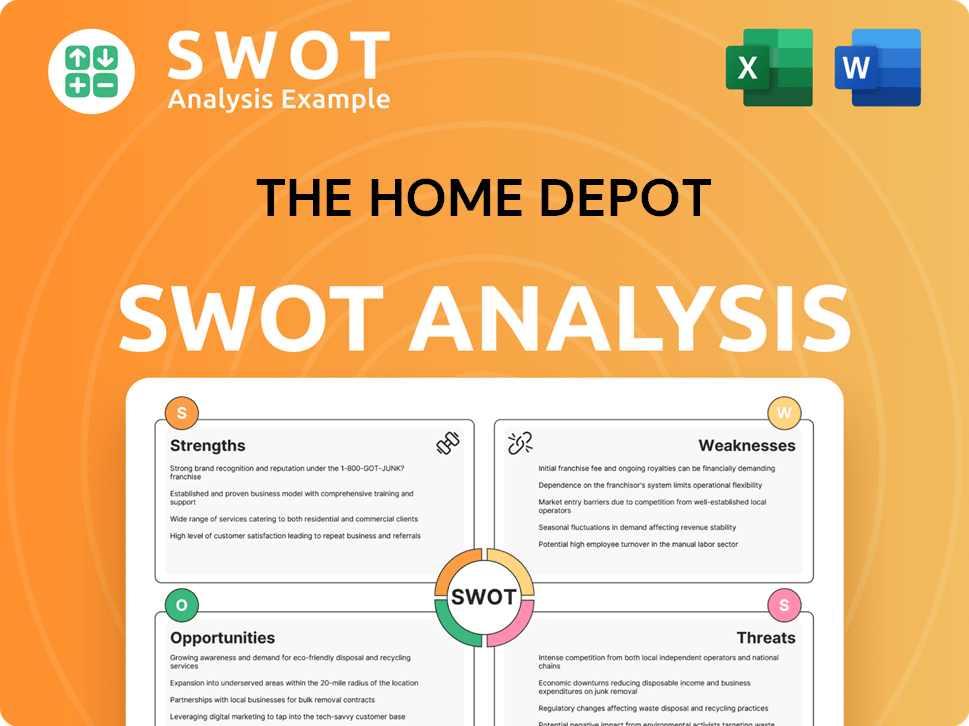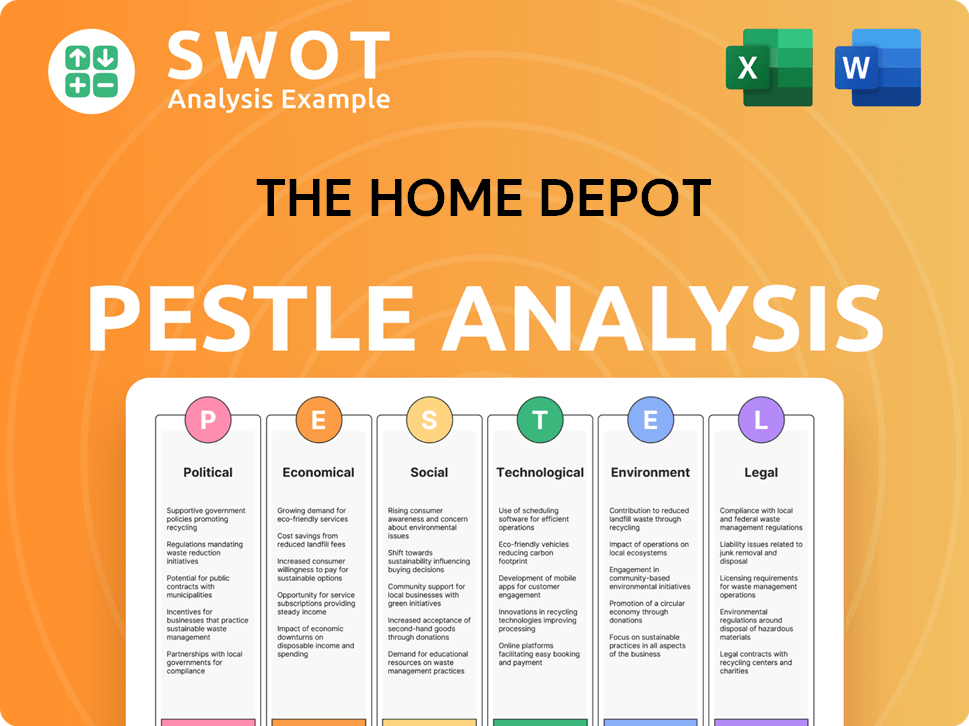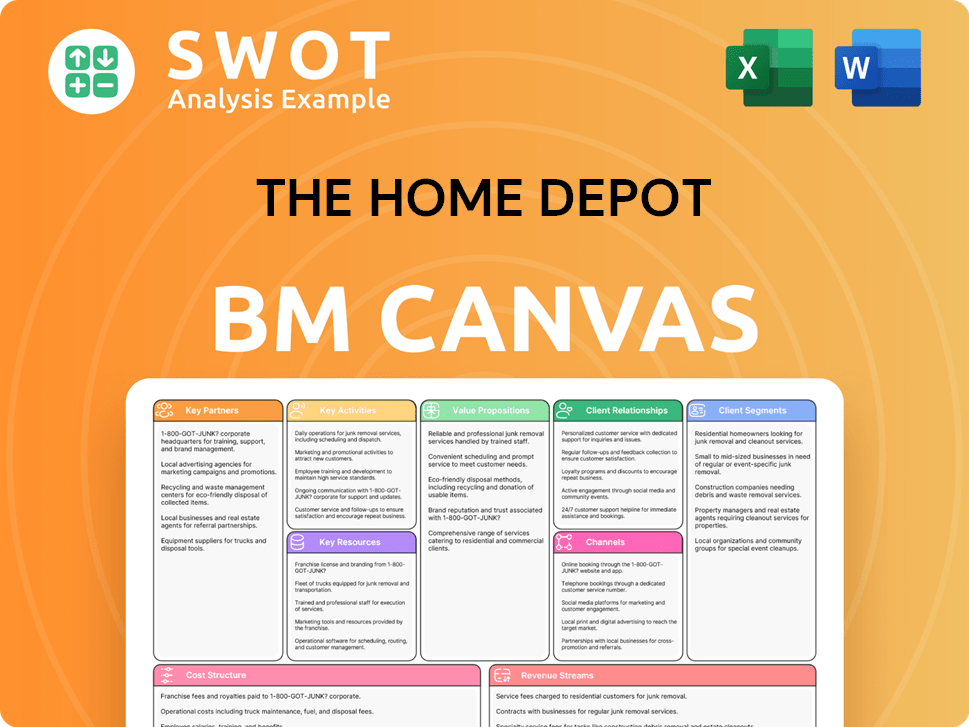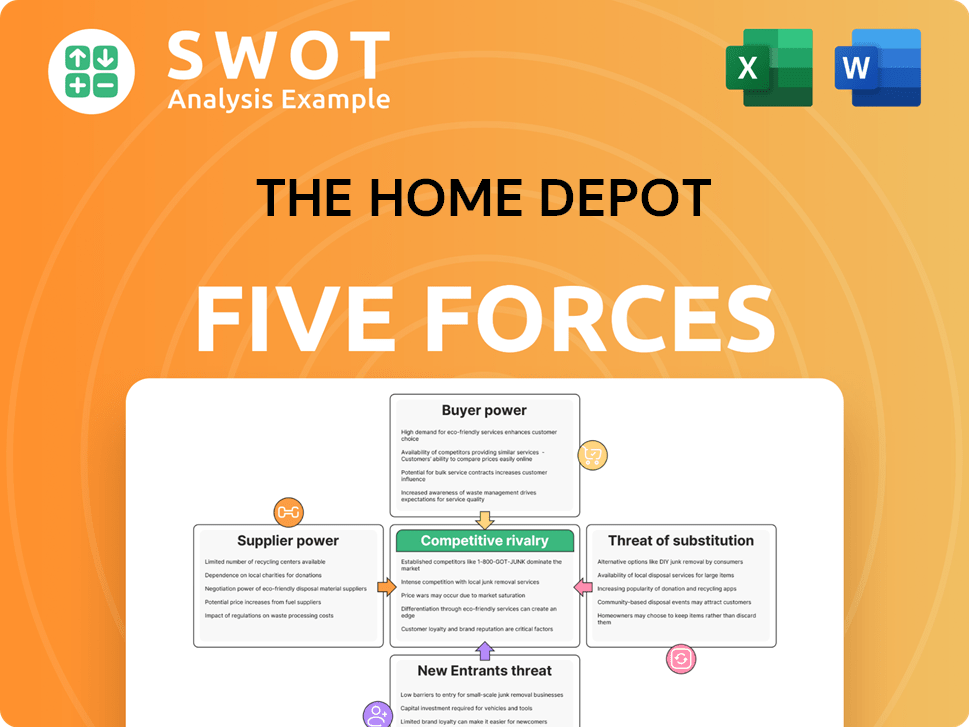The Home Depot Bundle
How Did Home Depot Revolutionize Home Improvement?
Imagine a world before the mega-store, where home improvement meant navigating a maze of small hardware shops. The Home Depot company didn't just enter this landscape; it completely redefined it. From its early days, this retail giant has transformed how we approach DIY projects and contractor needs. This is the story of a company that built an empire, one hammer and nail at a time.

Delving into the Home Depot history reveals a fascinating Home Depot timeline, showcasing how a simple idea blossomed into a global phenomenon. The Home Depot founders, Bernie Marcus, Arthur Blank, Ron Brill, and Pat Farrah, set out to create more than just a store; they envisioned a comprehensive resource. Their initial business model, focused on value and expertise, fueled rapid Home Depot growth and set the stage for its enduring success. To understand more about the company's strategic position, consider The Home Depot SWOT Analysis.
What is the The Home Depot Founding Story?
The story of the Home Depot company begins on June 29, 1978. This is when Bernie Marcus, Arthur Blank, Ron Brill, and Pat Farrah came together to create a new kind of home improvement store. Their vision was to revolutionize the home improvement retail landscape.
The founders, previously executives at Handy Dan Home Improvement Centers, were fired in 1978. This event became the catalyst for their innovative concept. They aimed to establish a large-format retail space offering a broad selection of products at competitive prices, coupled with exceptional customer service.
The initial problem they identified was the fragmented and often inconvenient nature of home improvement shopping. Their solution was a warehouse-style approach, stocking a vast inventory of building materials, tools, and home improvement products. The company's name, 'The Home Depot,' was chosen to reflect its comprehensive nature, a 'depot' for all home-related needs.
The early days of Home Depot were marked by a bold vision and innovative approach to retail. The founders' collective expertise in retail and operations, combined with their disruptive business model, was instrumental in overcoming the challenges.
- The first stores opened in Atlanta, Georgia.
- Initial funding came from personal savings and venture capital.
- Ken Langone played a key role in securing capital.
- The founders developed their initial business plan on a cocktail napkin.
The initial business model focused on a warehouse-style approach, stocking an extensive inventory of building materials, tools, and home improvement products. The first product offerings catered to both DIY customers and professional contractors. The economic context of the late 1970s, with a growing interest in home ownership and DIY projects, provided a fertile ground for their venture. The Competitors Landscape of The Home Depot has evolved significantly since its inception.
The company's early success was driven by its ability to offer lower prices, wider selections, and knowledgeable staff. This approach quickly resonated with customers, fueling rapid growth and expansion.
In 2024, the home improvement market continues to be a significant sector, with companies like Home Depot constantly adapting to changing consumer preferences and economic conditions. The company's early focus on customer service and competitive pricing set the stage for its lasting impact on the home improvement industry.
The Home Depot SWOT Analysis
- Complete SWOT Breakdown
- Fully Customizable
- Editable in Excel & Word
- Professional Formatting
- Investor-Ready Format

What Drove the Early Growth of The Home Depot?
The early growth of The Home Depot, a pivotal moment in its Home Depot history, was marked by rapid expansion and a strategic understanding of its target market. Following the opening of its first two stores in 1979, the company quickly expanded its presence. This period was crucial for establishing the foundation of what would become a retail giant, significantly impacting the Home Depot company and the home improvement industry.
The Home Depot's early expansion began with the opening of its first stores in Florida by 1981, showcasing its initial geographical reach. This move was a key step in establishing a broader customer base. The company's ability to quickly establish a presence in new markets was a testament to its efficient operational strategies.
In 1981, The Home Depot went public, a strategic move that provided the capital necessary for further expansion. This financial injection allowed the company to accelerate its growth plans. The Home Depot's stock market history began with this initial public offering, which played a vital role in its expansion.
Early product launches focused on broadening the assortment of home improvement categories, including lumber, plumbing, electrical, and paint. The company's strategy of offering competitive pricing and a vast selection quickly resonated with customers. This approach helped establish Home Depot stores as a one-stop shop for home improvement needs.
Initial team expansion involved recruiting knowledgeable associates who could provide expert advice, a cornerstone of their customer service philosophy. The warehouse format allowed for efficient inventory management and a visual display of the extensive product range. This customer-centric approach distinguished Home Depot's early operations.
Key acquisitions in the early years included the purchase of six Mr. HOW stores in 1984, which further accelerated their store count. Leadership transitions saw the continued guidance of Marcus and Blank, who fostered a strong company culture centered on customer focus and associate empowerment. These moves were critical to Home Depot's growth.
The market reception was overwhelmingly positive, as consumers embraced the convenience and value offered by The Home Depot. The competitive landscape, initially dominated by smaller, specialized hardware stores, was significantly disrupted by Home Depot's large-format model. This period saw pivotal decisions to invest heavily in inventory and store infrastructure, shaping the company's trajectory as a dominant force in retail.
By the end of the 1980s, The Home Depot had established itself as a national player with a rapidly growing store footprint and increasing revenue. This period was a critical foundation for the company's future success. This early phase set the stage for Home Depot's continued expansion and dominance in the home improvement sector. For more details on the company's journey, you can explore the comprehensive history of the company.
The early days of Home Depot were marked by strategic decisions that shaped its trajectory. From its founding date to its initial business model, every choice contributed to its growth. The focus on customer service and competitive pricing helped establish its place in the market. The company's Home Depot's founders' names, were instrumental in driving this early success.
The Home Depot PESTLE Analysis
- Covers All 6 PESTLE Categories
- No Research Needed – Save Hours of Work
- Built by Experts, Trusted by Consultants
- Instant Download, Ready to Use
- 100% Editable, Fully Customizable

What are the key Milestones in The Home Depot history?
The Home Depot company has a rich history marked by significant milestones that have shaped its trajectory in the home improvement industry. From its humble beginnings to its current status as a retail giant, the company's journey reflects its adaptability and strategic vision.
| Year | Milestone |
|---|---|
| 1978 | Founded by Bernard Marcus, Arthur Blank, Ron Brill, and Pat Farrah, the first Home Depot stores opened in Atlanta, Georgia. |
| 1981 | The company went public, marking a significant step in its growth and expansion. |
| 1990s | Home Depot expanded its professional contractor services, recognizing the importance of this segment. |
| 2000s | The company launched its e-commerce platform, adapting to the digital age. |
| 2023 | Online sales reached approximately $19.2 billion in fiscal year 2023. |
The Home Depot has consistently embraced innovation to maintain its competitive edge. A key innovation was the introduction of the 'big box' retail concept, offering a vast selection of products under one roof. This model revolutionized the home improvement sector and changed consumer expectations.
The 'big box' retail model provided an unparalleled selection of products under one roof, changing consumer expectations in the home improvement sector.
Expanded services catered to professional contractors, recognizing the importance of this segment to overall business growth.
The development of an e-commerce platform was a crucial step in adapting to the digital age, becoming a multi-billion dollar segment.
Significant investments in the supply chain to improve efficiency and customer experience, with capital expenditures projected to be around $3.5 billion in fiscal year 2024.
Prioritizing associate well-being, especially during challenging times such as the COVID-19 pandemic, to ensure operational resilience.
Robust inventory management practices to mitigate supply chain disruptions and meet customer demand effectively.
The Home Depot's journey has not been without its challenges. Economic downturns, such as the 2008 housing market crash, significantly impacted the company's sales and profits. Competitive pressures from rivals like Lowe's and smaller, specialized retailers have always necessitated strategic adaptation.
The housing market crash of 2008 led to a decline in sales and profits, highlighting the impact of economic cycles.
Competition from Lowe's and other retailers has required strategic adaptation and continuous improvement in offerings and services.
The COVID-19 pandemic caused supply chain disruptions, requiring robust inventory management and expanded online capabilities.
Underperforming products or categories necessitated adjustments to inventory and merchandising strategies to maintain profitability.
Navigating leadership changes and strategic realignments has been essential for staying competitive and adapting to market dynamics.
Prioritizing employee safety during the COVID-19 pandemic, implementing measures to ensure a safe working environment.
The Home Depot Business Model Canvas
- Complete 9-Block Business Model Canvas
- Effortlessly Communicate Your Business Strategy
- Investor-Ready BMC Format
- 100% Editable and Customizable
- Clear and Structured Layout

What is the Timeline of Key Events for The Home Depot?
The Home Depot company has a rich history, marked by significant milestones that have shaped its growth and influence in the home improvement industry. From its founding in 1978 to its current position as a leading retailer, the company's journey reflects strategic expansions, innovative approaches, and adaptations to market changes.
| Year | Key Event |
|---|---|
| 1978 | Founded by Bernie Marcus, Arthur Blank, Ron Brill, and Pat Farrah. |
| 1979 | The first two Home Depot stores opened in Marietta and Decatur, Georgia, marking the beginning of its retail presence. |
| 1981 | The company went public, a pivotal step in its financial growth. |
| 1984 | Acquired six Mr. HOW stores, which expanded its market reach. |
| 1989 | Reached $2 billion in sales, a significant financial achievement. |
| 1997 | Opened its 500th store, demonstrating rapid expansion. |
| 2000 | Bernie Marcus retired as CEO, and Bob Nardelli took over leadership. |
| 2006 | Launched its first eco-friendly product line, reflecting a commitment to sustainability. |
| 2007 | Frank Blake was appointed CEO. |
| 2008 | Faced challenges during the housing market crisis. |
| 2014 | Craig Menear became CEO. |
| 2020-2021 | Experienced significant growth during the COVID-19 pandemic. |
| 2022 | Ted Decker was appointed CEO and President. |
| 2024 | Continues to focus on its 'One Home Depot' strategy, integrating physical and digital retail experiences. |
The company is heavily investing in its interconnected retail experience, creating a seamless blend of online and in-store shopping. This strategy aims to enhance customer convenience and satisfaction, providing multiple touchpoints for purchases and support. This approach includes initiatives to improve the online platform and integrate digital tools within physical stores.
Significant efforts are being made to enhance supply chain capabilities, focusing on efficiency and responsiveness. This includes optimizing logistics, improving inventory management, and ensuring timely product delivery. Streamlining the supply chain is crucial for maintaining product availability and reducing operational costs.
The company is strengthening its focus on the pro customer segment, which includes professional contractors and tradespeople. This involves providing specialized products, services, and support tailored to their needs. This strategic focus aims to drive revenue growth and enhance customer loyalty within this key market segment.
The company is leveraging technology and data analytics to personalize customer experiences and optimize operations. This includes using data to understand customer preferences, improve product recommendations, and streamline internal processes. Technological advancements are central to its future growth strategy.
The Home Depot Porter's Five Forces Analysis
- Covers All 5 Competitive Forces in Detail
- Structured for Consultants, Students, and Founders
- 100% Editable in Microsoft Word & Excel
- Instant Digital Download – Use Immediately
- Compatible with Mac & PC – Fully Unlocked

Related Blogs
- What is Competitive Landscape of The Home Depot Company?
- What is Growth Strategy and Future Prospects of The Home Depot Company?
- How Does The Home Depot Company Work?
- What is Sales and Marketing Strategy of The Home Depot Company?
- What is Brief History of The Home Depot Company?
- Who Owns The Home Depot Company?
- What is Customer Demographics and Target Market of The Home Depot Company?
Disclaimer
All information, articles, and product details provided on this website are for general informational and educational purposes only. We do not claim any ownership over, nor do we intend to infringe upon, any trademarks, copyrights, logos, brand names, or other intellectual property mentioned or depicted on this site. Such intellectual property remains the property of its respective owners, and any references here are made solely for identification or informational purposes, without implying any affiliation, endorsement, or partnership.
We make no representations or warranties, express or implied, regarding the accuracy, completeness, or suitability of any content or products presented. Nothing on this website should be construed as legal, tax, investment, financial, medical, or other professional advice. In addition, no part of this site—including articles or product references—constitutes a solicitation, recommendation, endorsement, advertisement, or offer to buy or sell any securities, franchises, or other financial instruments, particularly in jurisdictions where such activity would be unlawful.
All content is of a general nature and may not address the specific circumstances of any individual or entity. It is not a substitute for professional advice or services. Any actions you take based on the information provided here are strictly at your own risk. You accept full responsibility for any decisions or outcomes arising from your use of this website and agree to release us from any liability in connection with your use of, or reliance upon, the content or products found herein.